This page is to let you know what a true original MGA radiator looks like, as the originals are so seldom seen these days. Over the decades most MGA radiators have been replaced or re-cored, and the replacements are often upgrades or more modern patterns in the core. This one has been chemically cleaned to remove most of the original black paint. It was also pressure tested and did not leak, so the stains on the filler side below the filler neck are from a little overflow (probably a failed pressure cap), not from any pressure leak.
 Of particular interest is the manufacturer's ID tag soldered to the back of the top tank just outboard of the filler neck. This tag is often removed during repair work, and may be replaced by an ID tag from the repair shop. The ID plate may also be relocated to the top side of the top tank, or to the top of the fan guard plate. The one below right is an original part from an original January 1959 MGA Coupe (compliments of Richard H. Northey. Of particular interest is the manufacturer's ID tag soldered to the back of the top tank just outboard of the filler neck. This tag is often removed during repair work, and may be replaced by an ID tag from the repair shop. The ID plate may also be relocated to the top side of the top tank, or to the top of the fan guard plate. The one below right is an original part from an original January 1959 MGA Coupe (compliments of Richard H. Northey.
|
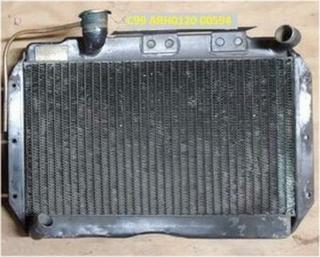
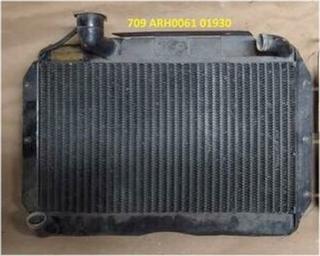
|
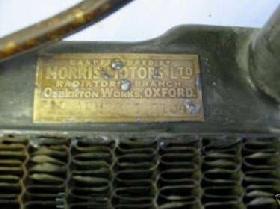
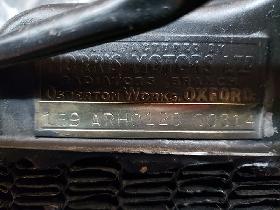
Beware that if you retain the original radiator for concours show, you run the risk of possible future leaks (as all original MGA radiators are now more than 50 years old). However, the original cell core radiator was very good at cooling the MGA engine, and many modern replacements do not fare as well.
The vertical core tubes do not at first seem visible from front or back. The vertical zigzag line in the core is the edge on view of the water cell. See following pages for more information.
The MGA service parts list issue 1 (green book) lists the radiator part number as ARH61. The second edition (Issue 2- February 1960-yellow cover) lists the part number as ARH120. The 1600 and 1600-MK-II (SPL issue 4) also list it as ARH120. Why the radiator part number was changed early in 1500 production is not known (yet).
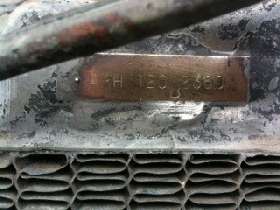


Sometime during production the radiator number tags changed twice. The Morris Motors Ltd. Radiator Branch plate was changed to a simpler type with stamping of the model number and production date only, as shown in these pictures. "ARH120" is the part number. Four digits following are the week and year of production. The first change type is a copper plate soldered to the rear of the top tank similar to the earlier plates. The later change type is a brass plate spot welded to the top of the fan guard. From these pictures, the first change occurred prior to 23rd week 1960, and the second change occurred prior to 28th week 1961. Garry Kemm in Victoria, Australia reports having the latest style stamped with 27th week 1960. So far it looks like the change from 2nd type to 3rd type happened between 23rd week and 27th week of 1960. If we get more reports of the date stamps this could be narrowed down some more.
Addendum March 31, 2015:
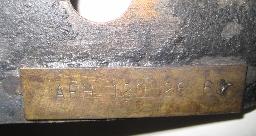 On 3/31/2015, Jim Stout wrote:
On 3/31/2015, Jim Stout wrote:
"This tag is from a car manufactured in August 1961 that I have owned since 1979".
Front stamped. This is a brass tag dated 26th week 1960. That would be a mismatch of dates. It is unlikely the original radiator would have been manufactured 14 months before the car's production date. I suppose this radiator is a transplant.

The one at right was found on car no 108477, very late in production. Reverse stamped, another change of tag style.
Addendum August 20, 2015:
The one below appears to be a replacement radiator, dated 4th week of 1962, being found in car HDK43/50308 assembled in March 1958. So far the additional "NG" tag is a mystery. Photos from Robert Mueller in Bavaria, Germany
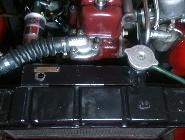

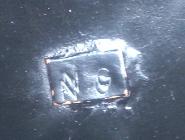
Addendum August 22, 2023:
 Here is a picture of the attached part number tag for the early production MGA radiator.part number "ARH0061".
Here is a picture of the attached part number tag for the early production MGA radiator.part number "ARH0061".
The Issue 1 SPL has it listed as ARH61, with no reference to change of part number, and no chassis number for the change point.
The Issue 2 SPL has it listed as ARH120 with no back reference to the earlier part number.
My web site seems to be the only on-line reference to this early part number. -- So far we do not know if there was any physical change other than the part number.
On Aug 24, 2023, Bob Shafto in New Hudson, MI, USA wrote:
"I have a C99 ARH0120 and a 709 AHR0061. I see two differences. First is the overflow pipe the ARH0120 does not extend to the bottom of the radiator like the ARH0061, but it also looks like a repair job. Second is the angle of the drain boss the ARH0120 is straight down but the ARH0061 is at an angle".
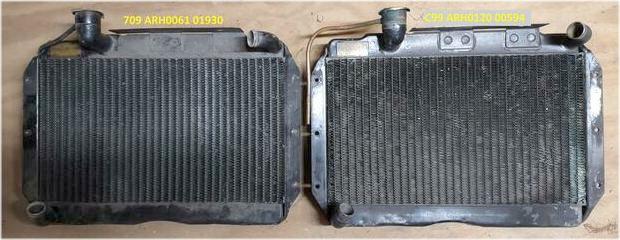
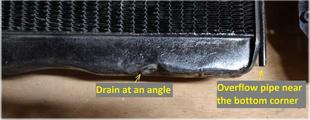

|